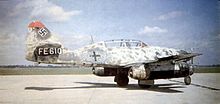Wenzendorf plant
The Wenzendorf plant was an aircraft yard near Wenzendorf , Lower Saxony, owned by Hamburger Flugzeugbau (HFB), a subsidiary of Blohm & Voss . Between 1935 and 1944 the HFB built around 600 aircraft there, including the Messerschmitt Me 262 jet fighter .
history
At the beginning of the 1930s, the management of the Blohm & Voss shipyard in Hamburg was looking for an area for an assembly plant for land aircraft for its subsidiary Hamburger Flugzeugbau. When choosing a suitable area, it was essential that Weser-Flugzeugbau should deliver the fuselage from Bremen and that it was intended as a supplier for the new plant. All high-lying areas that appeared to be sufficient for a 1000 m circle and were conveniently located in terms of traffic were examined on a general staff map.
With the approval of the Reich Aviation Ministry , the choice fell on Wenzendorf after a visit. The plant was built about 25 km from the Blohm & Voss headquarters in Hamburg-Steinwerder on the green field. From the Drestedt train station, a works railway line was completed on the site within four weeks. This siding was dismantled after the war. Since the railway line remained unused after that, the former route can still be seen today through the vegetation.
In order to make the location more attractive, in addition to an estate for administration and canteen, a “ single home ” and terraced houses for management staff (west of the airfield) were built. The latter are still standing today. These houses were special for the agricultural Wenzendorf because after the war there was much more urgently needed living space available here than in comparable villages. Many expellees, refugees and bombed-out people found their first accommodation in the factory estate, and a number of families are still living there in the second and third generation.
The plant was inaugurated at the end of September 1935. The first aircraft, a Dornier Do 23 , flew in December 1935. By 1940 around 600 aircraft of various types had been assembled and delivered. In the years that followed, mainly single-seaters were converted into two-seaters (used as training aircraft or night fighters).

fighter with antenna of the FuG 218 Neptune radar at the front
(photo 1945/46 during tests in the USA)
In mid-1944, the delivery of the Me 262 jet fighter and the development of new types of glide bombs and glide torpedoes began. The east bordering Reichsstrasse 3 served as an emergency take-off and landing runway at the end of the war.
The facility was badly damaged in a bombing raid by the US 8th Air Fleet on October 6, 1944 and almost completely destroyed in a second attack three months later. The plant was not rebuilt and completely blown up after the war.
Usage today
The northwestern strip of the former site serves today as the Wenzendorf glider airfield and is home to the Airbus HFB Fluggemeinschaft eV The remaining part is used for agriculture.
location
The following coordinates roughly correspond to the middle of today's glider trajectory: 53 ° 20 ′ 19 ″ N , 9 ° 46 ′ 50 ″ E
In aerial and satellite images, the former factory premises can still be seen very well in its hexagonal, slightly rounded shape in the areas used for agriculture today.
Web links
- Flugzeugwerk und Flugplatz Wenzendorf - a detailed article about the Wenzendorf plant on geschichtsspuren.de (formerly lostplaces.de)